Unit 5 Let’s celebrate单元知识点整理学案
文档属性
| 名称 | Unit 5 Let’s celebrate单元知识点整理学案 | 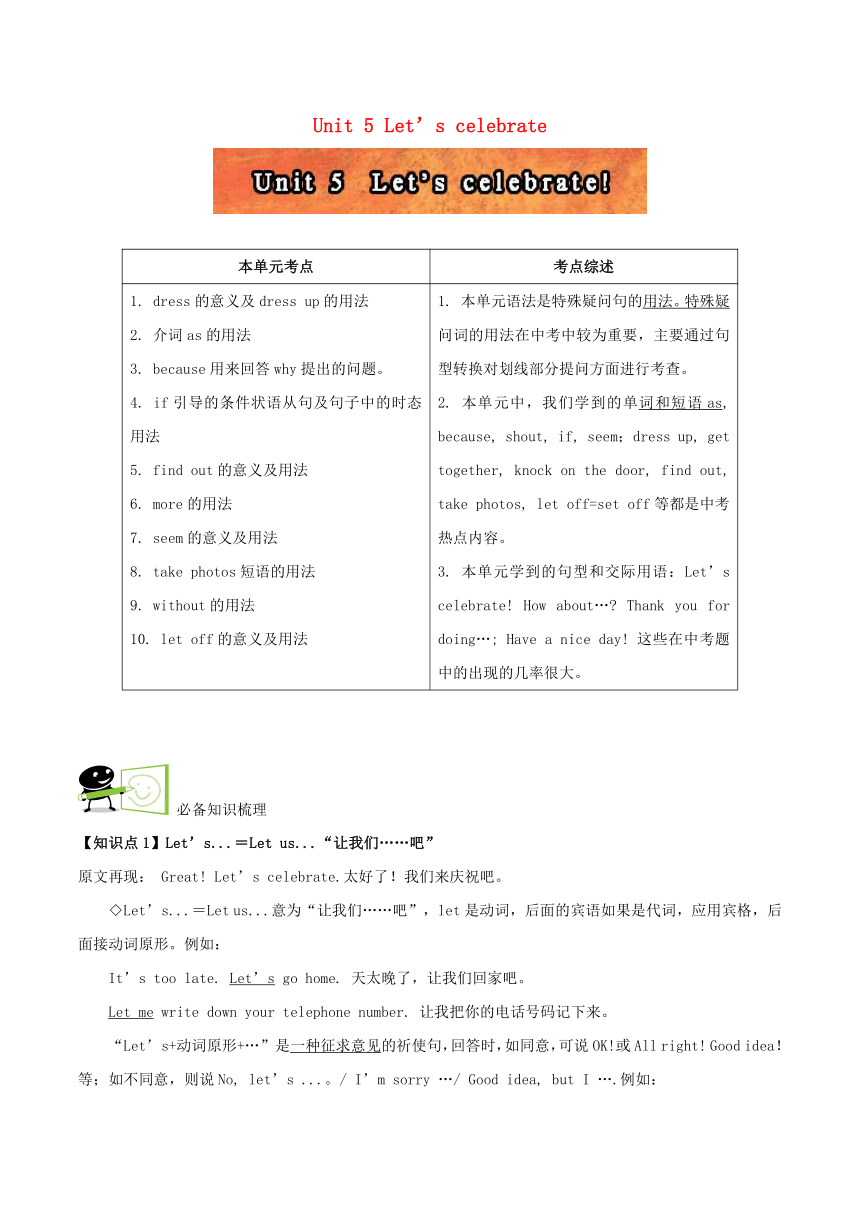 | |
| 格式 | zip | ||
| 文件大小 | 134.5KB | ||
| 资源类型 | 教案 | ||
| 版本资源 | 牛津译林版 | ||
| 科目 | 英语 | ||
| 更新时间 | 2016-08-26 07:54:09 | ||
图片预览

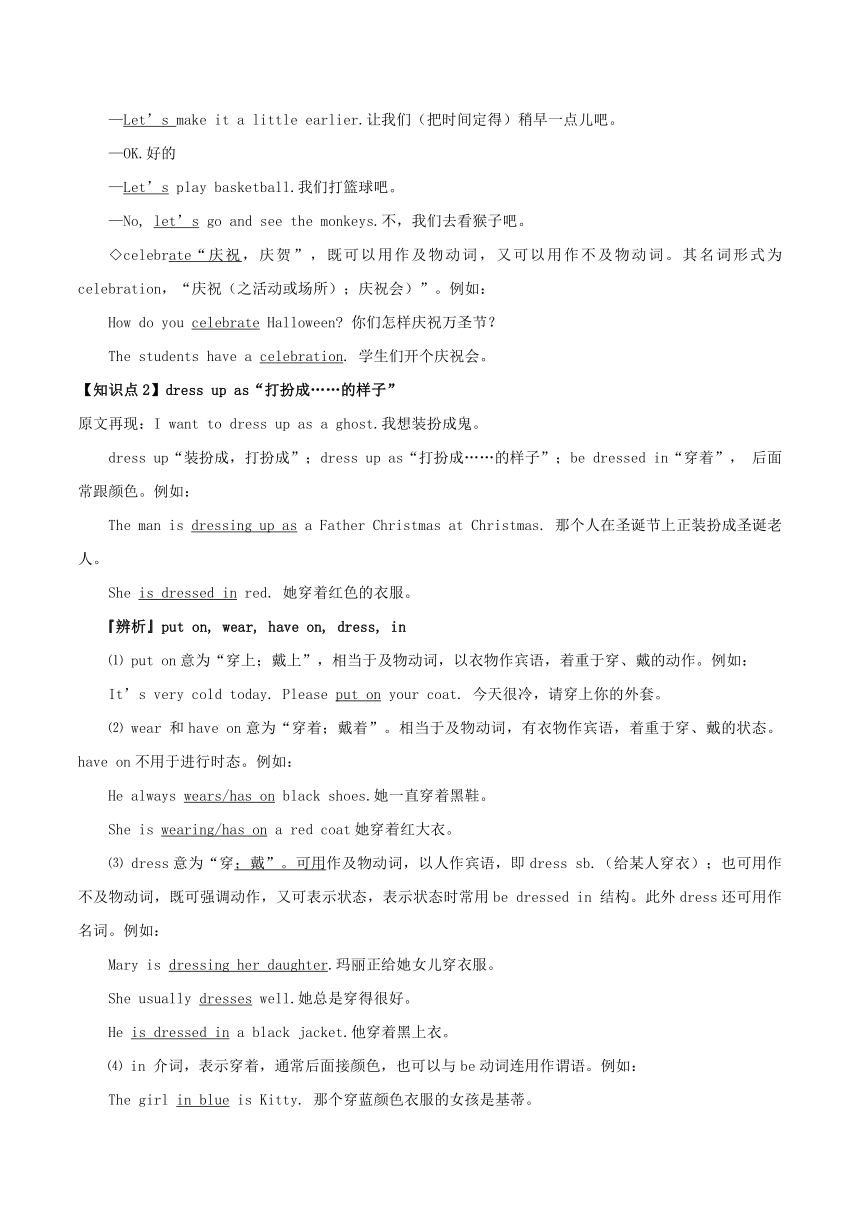
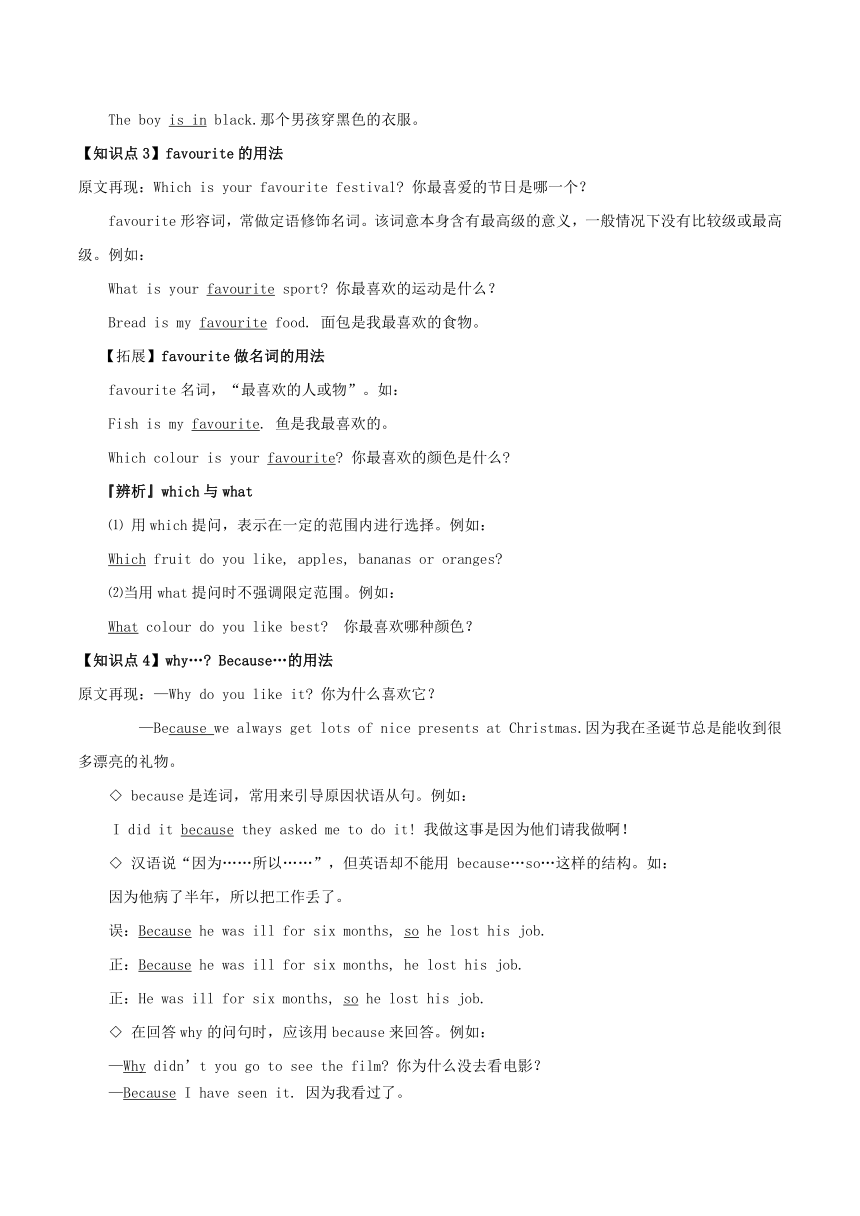
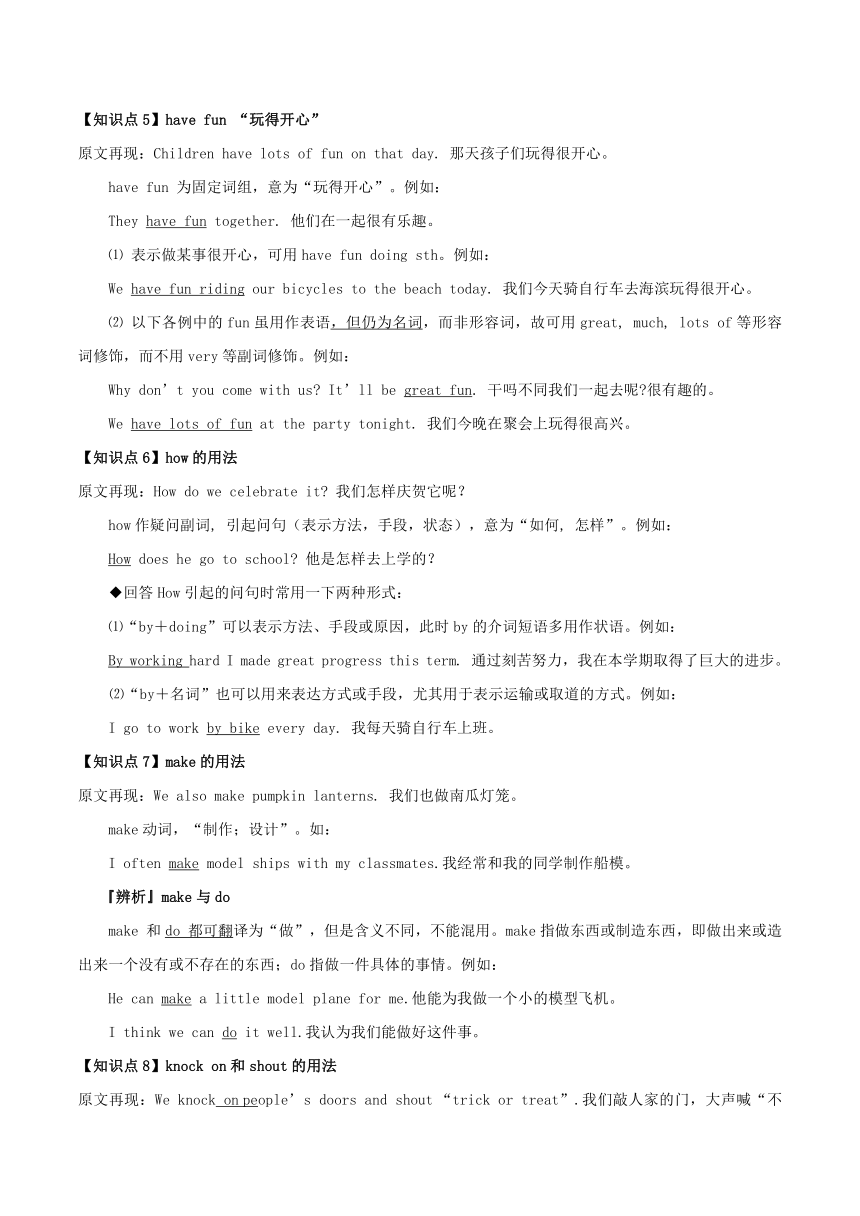
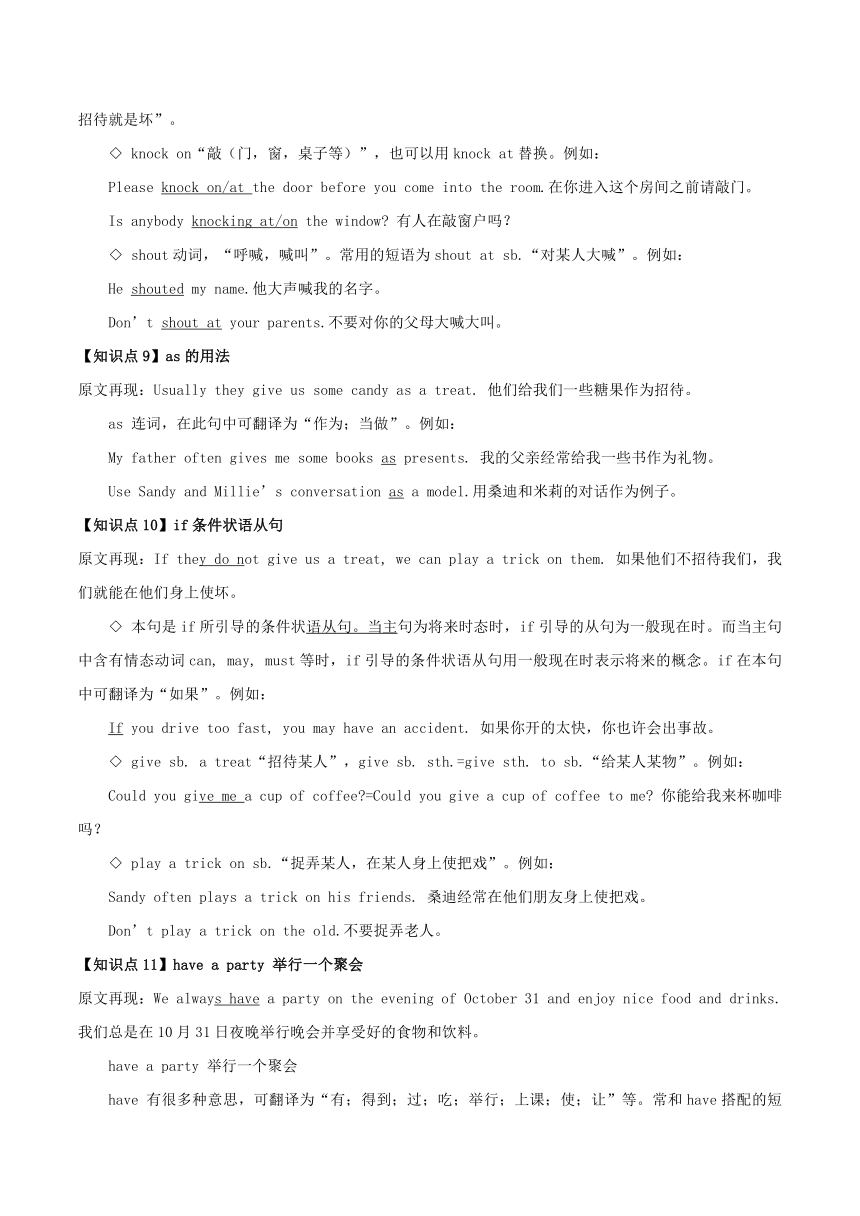
文档简介
Unit
5
Let’s
celebrate
本单元考点
考点综述
1.
dress的意义及dress
up的用法2.
介词as的用法3.
because用来回答why提出的问题。4.
if引导的条件状语从句及句子中的时态用法5.
find
out的意义及用法6.
more的用法7.
seem的意义及用法8.
take
photos短语的用法9.
without的用法10.
let
off的意义及用法
1.
本单元语法是特殊疑问句的用法。特殊疑
( http: / / www.21cnjy.com )问词的用法在中考中较为重要,主要通过句型转换对划线部分提问方面进行考查。2.
本单元中,我们学到的单词和短语as
( http: / / www.21cnjy.com ),
because,
shout,
if,
seem;dress
up,
get
together,
knock
on
the
door,
find
out,
take
photos,
let
off=set
off等都是中考热点内容。3.
本单元学到的句型和交际用语:Let’s
celebrate!
How
about…
Thank
you
for
doing…;
Have
a
nice
day!
这些在中考题中的出现的几率很大。
必备知识梳理
【知识点1】Let’s...=Let
us...“让我们……吧”
原文再现:
Great!
Let’s
celebrate.太好了!我们来庆祝吧。
◇Let’s...=Let
us...意为“让我们……吧”,let是动词,后面的宾语如果是代词,应用宾格,后面接动词原形。例如:
It’s
too
late.
Let’s
go
home.
天太晚了,让我们回家吧。
Let
me
write
down
your
telephone
number.
让我把你的电话号码记下来。
“Let’s+动词原形+…”是一种征求意见
( http: / / www.21cnjy.com )的祈使句,回答时,如同意,可说OK!或All
right!
Good
idea!等;如不同意,则说No,
let’s
...。/
I’m
sorry
…/
Good
idea,
but
I
….例如:
—Let’s
make
it
a
little
earlier.让我们(把时间定得)稍早一点儿吧。
—OK.好的
—Let’s
play
basketball.我们打篮球吧。
—No,
let’s
go
and
see
the
monkeys.不,我们去看猴子吧。
◇celebrate“庆祝
( http: / / www.21cnjy.com ),庆贺”,既可以用作及物动词,又可以用作不及物动词。其名词形式为celebration,“庆祝(之活动或场所);庆祝会)”。例如:
How
do
you
celebrate
Halloween
你们怎样庆祝万圣节?
The
students
have
a
celebration.
学生们开个庆祝会。
【知识点2】dress
up
as“打扮成……的样子”
原文再现:I
want
to
dress
up
as
a
ghost.我想装扮成鬼。
dress
up“装扮成,打扮成”;dress
up
as“打扮成……的样子”;be
dressed
in“穿着”,
后面常跟颜色。例如:
The
man
is
dressing
( http: / / www.21cnjy.com )
up
as
a
Father
Christmas
at
Christmas.
那个人在圣诞节上正装扮成圣诞老人。
She
is
dressed
in
red.
她穿着红色的衣服。
『辨析』put
on,
wear,
have
on,
dress,
in
⑴
put
on意为“穿上;戴上”,相当于及物动词,以衣物作宾语,着重于穿、戴的动作。例如:
It’s
very
cold
today.
Please
put
on
your
coat.
今天很冷,请穿上你的外套。
⑵
wear
和have
on意为“穿着;戴着”。相当于及物动词,有衣物作宾语,着重于穿、戴的状态。have
on不用于进行时态。例如:
He
always
wears/has
on
black
shoes.她一直穿着黑鞋。
She
is
wearing/has
on
a
red
coat她穿着红大衣。
⑶
dress意为“穿;戴”。可用
( http: / / www.21cnjy.com )作及物动词,以人作宾语,即dress
sb.(给某人穿衣);也可用作不及物动词,既可强调动作,又可表示状态,表示状态时常用be
dressed
in
结构。此外dress还可用作名词。例如:
Mary
is
dressing
her
daughter.玛丽正给她女儿穿衣服。
She
usually
dresses
well.她总是穿得很好。
He
is
dressed
in
a
black
jacket.他穿着黑上衣。
⑷
in
介词,表示穿着,通常后面接颜色,也可以与be动词连用作谓语。例如:
The
girl
in
blue
is
Kitty.
那个穿蓝颜色衣服的女孩是基蒂。
The
boy
is
in
black.那个男孩穿黑色的衣服。
【知识点3】favourite的用法
原文再现:Which
is
your
favourite
festival
你最喜爱的节日是哪一个?
favourite形容词,常做定语修饰名词。该词意本身含有最高级的意义,一般情况下没有比较级或最高级。例如:
What
is
your
favourite
sport
你最喜欢的运动是什么?
Bread
is
my
favourite
food.
面包是我最喜欢的食物。
【拓展】favourite做名词的用法
favourite名词,“最喜欢的人或物”。如:
Fish
is
my
favourite.
鱼是我最喜欢的。
Which
colour
is
your
favourite
你最喜欢的颜色是什么
『辨析』which与what
⑴
用which提问,表示在一定的范围内进行选择。例如:
Which
fruit
do
you
like,
apples,
bananas
or
oranges
⑵当用what提问时不强调限定范围。例如:
What
colour
do
you
like
best
你最喜欢哪种颜色?
【知识点4】why…
Because…的用法
原文再现:—Why
do
you
like
it
你为什么喜欢它?
—Because
( http: / / www.21cnjy.com )we
always
get
lots
of
nice
presents
at
Christmas.因为我在圣诞节总是能收到很多漂亮的礼物。
◇
because是连词,常用来引导原因状语从句。例如:
I
did
it
because
they
asked
me
to
do
it!
我做这事是因为他们请我做啊!
◇
汉语说“因为……所以……”,但英语却不能用
because…so…这样的结构。如:
因为他病了半年,所以把工作丢了。
误:Because
he
was
ill
for
six
months,
so
he
lost
his
job.
正:Because
he
was
ill
for
six
months,
he
lost
his
job.
正:He
was
ill
for
six
months,
so
he
lost
his
job.
◇
在回答why的问句时,应该用because来回答。例如:
—Why
didn’t
you
go
to
see
the
film
你为什么没去看电影?
—Because
I
have
seen
it.
因为我看过了。
【知识点5】have
fun
“玩得开心”
原文再现:Children
have
lots
of
fun
on
that
day.
那天孩子们玩得很开心。
have
fun
为固定词组,意为“玩得开心”。例如:
They
have
fun
together.
他们在一起很有乐趣。
⑴
表示做某事很开心,可用have
fun
doing
sth。例如:
We
have
fun
riding
our
bicycles
to
the
beach
today.
我们今天骑自行车去海滨玩得很开心。
⑵
以下各例中的fun虽用作表语,但仍为名词
( http: / / www.21cnjy.com ),而非形容词,故可用great,
much,
lots
of等形容词修饰,而不用very等副词修饰。例如:
Why
don’t
you
come
with
us
It’ll
be
great
fun.
干吗不同我们一起去呢 很有趣的。
We
have
lots
of
fun
at
the
party
tonight.
我们今晚在聚会上玩得很高兴。
【知识点6】how的用法
原文再现:How
do
we
celebrate
it
我们怎样庆贺它呢?
how作疑问副词,
引起问句(表示方法,手段,状态),意为“如何,
怎样”。例如:
How
does
he
go
to
school
他是怎样去上学的?
◆回答How引起的问句时常用一下两种形式:
⑴“by+doing”可以表示方法、手段或原因,此时by的介词短语多用作状语。例如:
By
working
( http: / / www.21cnjy.com )hard
I
made
great
progress
this
term.
通过刻苦努力,我在本学期取得了巨大的进步。
⑵“by+名词”也可以用来表达方式或手段,尤其用于表示运输或取道的方式。例如:
I
go
to
work
by
bike
every
day.
我每天骑自行车上班。
【知识点7】make的用法
原文再现:We
also
make
pumpkin
lanterns.
我们也做南瓜灯笼。
make动词,“制作;设计”。如:
I
often
make
model
ships
with
my
classmates.我经常和我的同学制作船模。
『辨析』make与do
make
和do
都可翻
( http: / / www.21cnjy.com )译为“做”,但是含义不同,不能混用。make指做东西或制造东西,即做出来或造出来一个没有或不存在的东西;do指做一件具体的事情。例如:
He
can
make
a
little
model
plane
for
me.他能为我做一个小的模型飞机。
I
think
we
can
do
it
well.我认为我们能做好这件事。
【知识点8】knock
on和shout的用法
原文再现:We
knock
on
pe
( http: / / www.21cnjy.com )ople’s
doors
and
shout
“trick
or
treat”.我们敲人家的门,大声喊“不招待就是坏”。
◇
knock
on“敲(门,窗,桌子等)”,也可以用knock
at替换。例如:
Please
knock
on/at
( http: / / www.21cnjy.com )the
door
before
you
come
into
the
room.在你进入这个房间之前请敲门。
Is
anybody
knocking
at/on
the
window
有人在敲窗户吗?
◇
shout动词,“呼喊,喊叫”。常用的短语为shout
at
sb.“对某人大喊”。例如:
He
shouted
my
name.他大声喊我的名字。
Don’t
shout
at
your
parents.不要对你的父母大喊大叫。
【知识点9】as的用法
原文再现:Usually
they
give
us
some
candy
as
a
treat.
他们给我们一些糖果作为招待。
as
连词,在此句中可翻译为“作为;当做”。例如:
My
father
often
gives
me
some
books
as
presents.
我的父亲经常给我一些书作为礼物。
Use
Sandy
and
Millie’s
conversation
as
a
model.用桑迪和米莉的对话作为例子。
【知识点10】if条件状语从句
原文再现:If
they
do
n
( http: / / www.21cnjy.com )ot
give
us
a
treat,
we
can
play
a
trick
on
them.
如果他们不招待我们,我们就能在他们身上使坏。
◇
本句是if所引导的条件状语从句。当主
( http: / / www.21cnjy.com )句为将来时态时,if引导的从句为一般现在时。而当主句中含有情态动词can,
may,
must等时,if引导的条件状语从句用一般现在时表示将来的概念。if在本句中可翻译为“如果”。例如:
If
you
drive
too
fast,
you
may
have
an
accident.
如果你开的太快,你也许会出事故。
◇
give
sb.
a
treat“招待某人”,give
sb.
sth.=give
sth.
to
sb.“给某人某物”。例如:
Could
you
give
me
( http: / / www.21cnjy.com )a
cup
of
coffee =Could
you
give
a
cup
of
coffee
to
me
你能给我来杯咖啡吗?
◇
play
a
trick
on
sb.“捉弄某人,在某人身上使把戏”。例如:
Sandy
often
plays
a
trick
on
his
friends.
桑迪经常在他们朋友身上使把戏。
Don’t
play
a
trick
on
the
old.不要捉弄老人。
【知识点11】have
a
party
举行一个聚会
原文再现:We
always
have
( http: / / www.21cnjy.com )
a
party
on
the
evening
of
October
31
and
enjoy
nice
food
and
drinks.
我们总是在10月31日夜晚举行晚会并享受好的食物和饮料。
have
a
party
举行一个聚会
have
有很多种意思,可翻译为“有;得到;过;吃;举行;上课;使;让”等。常和have搭配的短语有:
have
supper
吃晚餐
have
a
meeting
开会
have
a
big
family
有一个大家庭
have
an
English
lesson
上一节英语课
have
my
clothes
wash
让人洗我的衣服
另外,have还有一些固定的短语,如:
have
a
good
time
玩的开心/愉快
have
a
look看一看
【知识点12】think+从句
原文再现:She
thinks
it
is
really
a
special
day.她认为这确实是一个特殊的日子。
it
is
really
a
( http: / / www.21cnjy.com )special
day和上句中的the
day
is
interesting都在句子中作动词think的宾语,叫作宾语从句。宾语从句要用陈述句语序。如:
I
think
this
is
their
house
but
I’m
not
sure.
我想这是他们家,但不敢肯定。
I
can’t
think
what
you
mean.
我想像不出你是什麽意思。
【知识点13】特殊疑问句
由特殊疑问词或短语引导的疑问句,叫特殊
( http: / / www.21cnjy.com )疑问句。常见的特殊疑问词或短语有what,
who,
where,
how,
what
time,
how
much,
how
many,
how
long等。例如:
⑴
what“什么”,询问物品或活动。
—What
does
she
do?她是干什么工作的?
—She
is
a
doctor.
她是个医生。
—What’s
this/that?这(那)是什么?
—It’s
a
computer.这是一台电脑。
⑵
which“哪一个”,询问人或物。
—Which
one
do
you
like
你喜欢哪一个?
—I
like
the
red
one.我喜欢红色的那个。
⑶
who“谁”,询问人的。
Who
is
he
他是谁?
Who
do
you
go
shopping
with
你要和谁去购物?
⑷
whose“谁的”,询问所有者。
—Whose
book
is
this 这是谁的书?
—It
is
mine.
它是我的。
⑸
when“何时”,询问时间。
—When
do
you
usually
go
to
school
你通常几点去上学?
—I
usually
go
to
school
at
7a.m.我通常早上7点上学。
⑹
where“何地”,询问地点。
Where
is
the
library
图书馆在哪里?
Where
were
you
born
你出生在哪里?
⑺
why“为什么”,询问原因。如:
Why
do
you
like
playing
basketball
为何你喜欢打篮球?
⑻
how“如何”,询问方式。
How
do
you
go
to
work
every
day
你每天怎样去上班?
【知识点14】英语感叹句
原文再现:What
a
nice
cake!
多么漂亮的蛋糕!
英语感叹句多用how和what引导,how
和what与被修饰词放在句首,其它部分用陈述句语序。
⑴
What+名词+主语+谓语!wha
( http: / / www.21cnjy.com )t“多么”,作定语,修饰名词。单数可数名词前用what
a,复数名词和不可数名词前用what。例如:
What
a
big
box
it
is!
多大的盒子啊!
What
pictures
they
are!
多美的画呀!
⑵
How+形容词(副词)+主语+谓语!how“多么”,作状语,修饰形容词或副词。例如:
How
heavy
the
box
is!
这箱子多重啊!
How
fast
he
runs!
他跑得多快啊!
⑶
在口语中,感叹句中的主语和谓语可以略去。例如:
How
hot
(it
is)!
好热啊!
What
a
question!
问得多妙!
【知识点15】find
out用法
原文再现:Find
out
more
on
New
York
Radio.在纽约电台里找到更多(信息)。
find
out
动词短语,意为“找出,查明;发现,揭发”。例如:
You
can
find
out
more
information
on
the
Internet.
你在互联网上能查到会更多的信息。
How
do
we
find
out
about
it
我们怎么去发现这一点?
【拓展】find,
look
for和find
out
三者均有“找”的含义,但“找”的方式不一样。
⑴
find为“找到”,强调的是找的结果,通常指偶然发现。如:
I
found
my
bike
last
Sunday.
我上星期天找到我的自行车了。
⑵
look
for意为“寻找”,强调的是找的动作或过程。如:
Are
you
still
looking
for
that
place?你还在找那个地方吗?
⑶
find
out指经过观察、调查把某事、某物查出来,搞清楚、弄明白。如:
When
he
was
a
( http: / / www.21cnjy.com )child,
he
liked
to
find
out
how
things
worked.
当他还是个孩子时,就爱弄明白各种事物的来龙去脉。
【知识点16】on
holiday“度假”
原文再现:I
am
on
holiday
in
New
York.
我在纽约度假。
on
holiday“度假”,在句子中
( http: / / www.21cnjy.com )做表语或状语。for
holiday也有“度假”之意,但是它不能做表语;spend
holiday也可以翻译为“度假”,但在句中做谓语。例如:
We’re
going
on
holiday
next
month.我们下个月就要去度假了。
My
family
will
go
to
Nanjing
for
holiday.
我的家人要去南京度假。
Mr.
White
spends
holiday
in
Hong
Kong.
怀特先生在香港度假。
【知识点17】take和a
lot
of的用法
原文再现:People
take
a
lot
of
photos.
人们拍了很多照片。
◇
take
a
photo/
photos
拍照;take
some
photos
拍一些照片。例如:
Can
you
please
take
a
photo
for
us
你可以帮我们拍张照片吗?
I
can
take
a
photo
of
me
by
myself.
就算一个人的时候,我也能玩自拍。
Mark,
could
you
help
me
take
photos
马克,能帮我拍几张相片吗
◇
a
lot
of
许多的
例如:
There
are
a
lot
of
trees
on
the
hill.山上有许多树。
『辨析』a
lot
of,
lots
of和a
lot
⑴
a
lot
of
=
lots
o
( http: / / www.21cnjy.com )f,可修饰可数或不可数名词,意为“许多”,
“大量的”,相当于many或much。a
lot,
a
lot
of,
lots
of通常用于肯定句,否定句中一般用many或much,例如:
We
have
lots
of/
a
lot
of
vegetables
every
day.我们每天都吃许多蔬菜。
⑵
a
lot作副词短语,在句中作程度状语,表示“很;非常;常常”,修饰动词、感叹词、介词短语、形容词或副词的比较级等,例如:
Thanks
a
lot.
多谢!
It
usually
rains
a
lot
at
this
time
of
year.
每年这个时候都经常下雨。(修饰动词rain)
【知识点18】watch的用法
原文再现:At
night,
they
watch
the
fireworks.
晚上,他们观看烟花。
watch
动词,意为“观察;注视;看守”。例如:
Do
you
watch
the
news
on
TV
你在电视上看新闻节目吗?
『辨析』look,
look
at,
see和
watch
look,
look
at,
see,
watch
都有“看”的意思,但用法不同。
⑴
look为不及物动词,后面不能带宾语,常单独使用,以引起对方注意。例如:
Look!
That’s
an
English
car.
看!那是一辆英国的小汽车。
⑵
see为及物动词,意思是“看见”,侧重“看”的结果。例如:
Can
I
see
your
new
pen
我可以看看你的新钢笔吗?
⑶
watch是及物动词,意思是“观看、注视”,用来指注视移动着的物体,如看电视、看球赛、看戏等。
例如:
They
are
watching
TV.他们正在看电视
【知识点19】There
be
+名词+地点(时间)
原文再现:After
that,
there
is
a
music
and
dance
show.
在那之后,有一个音乐和舞蹈表演。
本句型为there
be结构。There
( http: / / www.21cnjy.com )
be
结构是英语中陈述事物客观存的常用句型,表示“有”,其确切含义是“存在”。there
作为引导词,本身没有意义,用动词be的某些形式作为谓语动词,它的主语是用一些表示泛指或不定特指的名词词组,动词be和主语的数必须一致。句子最后通常为表示地点和时间的状语。因此要表达“某个地方或某个时间存在什么事物或人”的时候常用:There
be
+名词+地点(时间)这一句型。例如:
There
are
some
students
in
the
bedroom.
在宿舍里有一些学生。
◇There
be结构中的主谓一致。
⑴
当动词be后所接的名词是单数可数名词或不可数名词时,be
应该取单数is;当其后所接的名词是复数的可数名词时,be用复数are。例如:
There’s
a
man
at
the
door.门口有个人。
There
is
some
apple
juice
in
the
bottle.
瓶子里有些苹果汁。
There
are
some
books
on
the
teacher’s
desk.
讲桌上有一些书。
⑵
如果There
be
后面是几个并列名词做主语时,动词be的形式和最靠近它的那个名词保持数的一致。例如:
There
is
a
clock
and
two
bottles
on
the
shelf.
架子上有一只座钟和两个瓶子。
There
are
two
bottles
and
a
clock
on
the
shelf.
架子上有两个瓶子和一个座钟。
【知识点20】no和without的用法
原文再现:There
is
no
smoke
without
fire.(谚语无风不起浪。
◇
no是英语中的一个常用词,可用作形容词、副词,也可用作名词。
⑴
用作副词。用作否定回答,意为“不”。例如:
—Did
you
go
to
the
beach
yesterday
你昨天去海滩了吗?
—No,
I
didn’t.
不,我没有去。
⑵
用作形容词。表示“没有”的意思,其后
( http: / / www.21cnjy.com )可接单、复数可数名词或不可数名词。相当于not
a,
not
one,
not
any。例如:
He
has
no
children.
他没有孩子。
There
is
no
water
in
the
bottle.
瓶子里没有水。
●修饰名词时,no不能与冠词、指示代
( http: / / www.21cnjy.com )词、物主代词以及some,
any,
much,
every等不定代词连用,但可与不定代词other连用。如:
他没有钱。
【误】
He
has
no
any
(his,
the)
money.
【正】
He
has
no
money.
/
He
has
not
any
money.
⑶
表示“禁止”或“不许”等意思,其后接动名词。如:
No
Parking!
不准停车!
No
Smoking!
禁止吸烟
⑷
表示“没有……就没有……”的意思,其后可接名词,相当于“no...
without...”如:
No
pains,
no
gains.
不劳无获。
◇
without是个兼类词,常用作介
( http: / / www.21cnjy.com )词,主要意思有“没有,毫无,不(反义词是with),如果没有,要没有(表示条件);不,没有(后面接名词)”。例如:
Tony
always
goes
out
without
a
cap
in
winter.
托尼冬天外出总是不戴帽子。
We
may
live
without
a
TV
set.
没有电视机我们也能活下去。
【知识点21】it和but的用法归纳
原文再现:It
is
often
col
( http: / / www.21cnjy.com )d
at
this
time
of
year,
but
people
are
happy.
每年的这个时候天气通常寒冷,但人们是快乐的。
◇
句子中的it指“天气”。例如:
It’s
very
cold
in
winter
in
Haerbin.哈尔滨的冬天很冷。
【拓展】it的一些用法归纳:
⑴
指代物。it可替代动植物与无生命的东西。
—Where
is
your
bike
你的自行车在哪里?
—It’s
under
the
big
tree.
它在大树下面。
⑵
指代人。it可指代一个未亲眼看到的、不明身份性别的、面目不详的人,或婴儿、儿童,照片中的人物等。
—Who
is
crying
in
the
room
谁在房间里哭?
—It’s
my
brother
Jack.
我弟弟杰克。
⑶
指代上文提到的内容,
或者是文中的内容。
—Thank
you
for
your
help.
谢谢你的帮助。
—Don’t
mention
it.别客气(不要提它)。
⑷
指时间。
—What
time
is
it
by
your
watch 你的手表几点了?
—It’s
ten
minutes
past
two.
差10分到两点。
⑸
指距离、速度、金钱、度量。
It’s
about
ten
kilometers
from
my
home
to
my
school.从我家到学校大约10公里。
◇
句中but是连词,意为“但是,然而”。可以连接两个并列成分或两个并列分句。
I
can
read
French,
but
I
can’t
speak
it.
我能看懂法文但不会说。
●but不能与though/
although连用。
【拓展】but的其他用法
⑴
作介词,常与nothing,
nobody,
who,
all等连用,意为“除……之外”。
We
had
nothing
to
do
but
wait.
除了等待之外,我们一筹莫展。
No
one
but
me
saw
him.
除了我之外,没人看到他。
⑵
作副词,意思接近于only,意为“只不过”。
She
is
but
a
young
girl.
她只不过是一个小女孩儿。
【知识点22】get…from的用法
原文再现:We
always
ge
( http: / / www.21cnjy.com )t
presents
from
our
grandparents,
parents,
aunts
and
uncles.
我们总是从祖父母、父母,阿姨和叔叔那里得到礼物。
get…from…意为“从……得到”。
We
get
light
and
heat
from
the
sun.
我们从太阳那里得到光和热。
I
get
a
letter
from
my
penfriend
today.
今天我收到我笔友的一封信。
直通中考
本单元的核心语法是特殊疑问句的用法,
( http: / / www.21cnjy.com )涉及到特殊疑问词what,
which,
who,
whose,
when,
where,
why和how。特殊疑问词的用法在中考中较为重要,主要通过句型转换对划线部分提问方面进行考查。
本单元中,我们学到了一些重要的单词和短
( http: / / www.21cnjy.com )语,如as,
because,
shout,
if,
other,
seem;dress
up,
get
together,
knock
on
the
door,
find
out,
take
photos,
at
night,
let
off=set
off等。
本单元学到了一些常用的句型和交际用语:
Let’s
celebrate!
How
about
the
Monkey
King
—Why
do
you
like
it
—Because
we
always
get
lots
of
nice
presents
at
Christmas.
—What
do
you
usually
do
on
Halloween
—We
play
games
and
have
lots
of
fun.
—How
do
you
go
to
school
—I
go
to
school
by
bus.
There
are
lots
of
interesting
things
at
the
party.
Thank
you
for
telling
me
about
the
Mid-Autumn
Festival.
Have
a
nice
day!
祝你快乐!
What
a
nice
cake!
这些在中考题中的出现的几率很大。
★经典考题解读
【考点1】考查dress的用法
(广西贵港)Although
( http: / / www.21cnjy.com )
Lucy
is
only
three
years
old,
she
is
able
to
_____
herself.
A.
put
B.
make
C.
wear
D.
dress
( http: / / www.21cnjy.com )【答案】D
【考点2】考查连词because的用法
(广西贺州)Tony
ne
( http: / / www.21cnjy.com )ver
spends
money
on
buying
books
______
he
doesn’t
like
reading.
A.
but
B.
because
C.
though
D.
until
【解析】考查连词辨析。句意:托尼从不花钱买
( http: / / www.21cnjy.com )书,_____他不喜欢读书。But“但是”;because“因为”;though“虽然,尽管”;until“直到”;根据前后句的意思,可知后面是原因,故选B。
【答案】B
【考点3】考查if引导的条件状语从句
(四川凉山)—Would
you
like
to
go
shopping
with
me,
Carmen?
—I’d
love
to,
you
don’t
want
to
go
alone.
A.
until
B.
before
C.
if
【答案】C
5
Let’s
celebrate
本单元考点
考点综述
1.
dress的意义及dress
up的用法2.
介词as的用法3.
because用来回答why提出的问题。4.
if引导的条件状语从句及句子中的时态用法5.
find
out的意义及用法6.
more的用法7.
seem的意义及用法8.
take
photos短语的用法9.
without的用法10.
let
off的意义及用法
1.
本单元语法是特殊疑问句的用法。特殊疑
( http: / / www.21cnjy.com )问词的用法在中考中较为重要,主要通过句型转换对划线部分提问方面进行考查。2.
本单元中,我们学到的单词和短语as
( http: / / www.21cnjy.com ),
because,
shout,
if,
seem;dress
up,
get
together,
knock
on
the
door,
find
out,
take
photos,
let
off=set
off等都是中考热点内容。3.
本单元学到的句型和交际用语:Let’s
celebrate!
How
about…
Thank
you
for
doing…;
Have
a
nice
day!
这些在中考题中的出现的几率很大。
必备知识梳理
【知识点1】Let’s...=Let
us...“让我们……吧”
原文再现:
Great!
Let’s
celebrate.太好了!我们来庆祝吧。
◇Let’s...=Let
us...意为“让我们……吧”,let是动词,后面的宾语如果是代词,应用宾格,后面接动词原形。例如:
It’s
too
late.
Let’s
go
home.
天太晚了,让我们回家吧。
Let
me
write
down
your
telephone
number.
让我把你的电话号码记下来。
“Let’s+动词原形+…”是一种征求意见
( http: / / www.21cnjy.com )的祈使句,回答时,如同意,可说OK!或All
right!
Good
idea!等;如不同意,则说No,
let’s
...。/
I’m
sorry
…/
Good
idea,
but
I
….例如:
—Let’s
make
it
a
little
earlier.让我们(把时间定得)稍早一点儿吧。
—OK.好的
—Let’s
play
basketball.我们打篮球吧。
—No,
let’s
go
and
see
the
monkeys.不,我们去看猴子吧。
◇celebrate“庆祝
( http: / / www.21cnjy.com ),庆贺”,既可以用作及物动词,又可以用作不及物动词。其名词形式为celebration,“庆祝(之活动或场所);庆祝会)”。例如:
How
do
you
celebrate
Halloween
你们怎样庆祝万圣节?
The
students
have
a
celebration.
学生们开个庆祝会。
【知识点2】dress
up
as“打扮成……的样子”
原文再现:I
want
to
dress
up
as
a
ghost.我想装扮成鬼。
dress
up“装扮成,打扮成”;dress
up
as“打扮成……的样子”;be
dressed
in“穿着”,
后面常跟颜色。例如:
The
man
is
dressing
( http: / / www.21cnjy.com )
up
as
a
Father
Christmas
at
Christmas.
那个人在圣诞节上正装扮成圣诞老人。
She
is
dressed
in
red.
她穿着红色的衣服。
『辨析』put
on,
wear,
have
on,
dress,
in
⑴
put
on意为“穿上;戴上”,相当于及物动词,以衣物作宾语,着重于穿、戴的动作。例如:
It’s
very
cold
today.
Please
put
on
your
coat.
今天很冷,请穿上你的外套。
⑵
wear
和have
on意为“穿着;戴着”。相当于及物动词,有衣物作宾语,着重于穿、戴的状态。have
on不用于进行时态。例如:
He
always
wears/has
on
black
shoes.她一直穿着黑鞋。
She
is
wearing/has
on
a
red
coat她穿着红大衣。
⑶
dress意为“穿;戴”。可用
( http: / / www.21cnjy.com )作及物动词,以人作宾语,即dress
sb.(给某人穿衣);也可用作不及物动词,既可强调动作,又可表示状态,表示状态时常用be
dressed
in
结构。此外dress还可用作名词。例如:
Mary
is
dressing
her
daughter.玛丽正给她女儿穿衣服。
She
usually
dresses
well.她总是穿得很好。
He
is
dressed
in
a
black
jacket.他穿着黑上衣。
⑷
in
介词,表示穿着,通常后面接颜色,也可以与be动词连用作谓语。例如:
The
girl
in
blue
is
Kitty.
那个穿蓝颜色衣服的女孩是基蒂。
The
boy
is
in
black.那个男孩穿黑色的衣服。
【知识点3】favourite的用法
原文再现:Which
is
your
favourite
festival
你最喜爱的节日是哪一个?
favourite形容词,常做定语修饰名词。该词意本身含有最高级的意义,一般情况下没有比较级或最高级。例如:
What
is
your
favourite
sport
你最喜欢的运动是什么?
Bread
is
my
favourite
food.
面包是我最喜欢的食物。
【拓展】favourite做名词的用法
favourite名词,“最喜欢的人或物”。如:
Fish
is
my
favourite.
鱼是我最喜欢的。
Which
colour
is
your
favourite
你最喜欢的颜色是什么
『辨析』which与what
⑴
用which提问,表示在一定的范围内进行选择。例如:
Which
fruit
do
you
like,
apples,
bananas
or
oranges
⑵当用what提问时不强调限定范围。例如:
What
colour
do
you
like
best
你最喜欢哪种颜色?
【知识点4】why…
Because…的用法
原文再现:—Why
do
you
like
it
你为什么喜欢它?
—Because
( http: / / www.21cnjy.com )we
always
get
lots
of
nice
presents
at
Christmas.因为我在圣诞节总是能收到很多漂亮的礼物。
◇
because是连词,常用来引导原因状语从句。例如:
I
did
it
because
they
asked
me
to
do
it!
我做这事是因为他们请我做啊!
◇
汉语说“因为……所以……”,但英语却不能用
because…so…这样的结构。如:
因为他病了半年,所以把工作丢了。
误:Because
he
was
ill
for
six
months,
so
he
lost
his
job.
正:Because
he
was
ill
for
six
months,
he
lost
his
job.
正:He
was
ill
for
six
months,
so
he
lost
his
job.
◇
在回答why的问句时,应该用because来回答。例如:
—Why
didn’t
you
go
to
see
the
film
你为什么没去看电影?
—Because
I
have
seen
it.
因为我看过了。
【知识点5】have
fun
“玩得开心”
原文再现:Children
have
lots
of
fun
on
that
day.
那天孩子们玩得很开心。
have
fun
为固定词组,意为“玩得开心”。例如:
They
have
fun
together.
他们在一起很有乐趣。
⑴
表示做某事很开心,可用have
fun
doing
sth。例如:
We
have
fun
riding
our
bicycles
to
the
beach
today.
我们今天骑自行车去海滨玩得很开心。
⑵
以下各例中的fun虽用作表语,但仍为名词
( http: / / www.21cnjy.com ),而非形容词,故可用great,
much,
lots
of等形容词修饰,而不用very等副词修饰。例如:
Why
don’t
you
come
with
us
It’ll
be
great
fun.
干吗不同我们一起去呢 很有趣的。
We
have
lots
of
fun
at
the
party
tonight.
我们今晚在聚会上玩得很高兴。
【知识点6】how的用法
原文再现:How
do
we
celebrate
it
我们怎样庆贺它呢?
how作疑问副词,
引起问句(表示方法,手段,状态),意为“如何,
怎样”。例如:
How
does
he
go
to
school
他是怎样去上学的?
◆回答How引起的问句时常用一下两种形式:
⑴“by+doing”可以表示方法、手段或原因,此时by的介词短语多用作状语。例如:
By
working
( http: / / www.21cnjy.com )hard
I
made
great
progress
this
term.
通过刻苦努力,我在本学期取得了巨大的进步。
⑵“by+名词”也可以用来表达方式或手段,尤其用于表示运输或取道的方式。例如:
I
go
to
work
by
bike
every
day.
我每天骑自行车上班。
【知识点7】make的用法
原文再现:We
also
make
pumpkin
lanterns.
我们也做南瓜灯笼。
make动词,“制作;设计”。如:
I
often
make
model
ships
with
my
classmates.我经常和我的同学制作船模。
『辨析』make与do
make
和do
都可翻
( http: / / www.21cnjy.com )译为“做”,但是含义不同,不能混用。make指做东西或制造东西,即做出来或造出来一个没有或不存在的东西;do指做一件具体的事情。例如:
He
can
make
a
little
model
plane
for
me.他能为我做一个小的模型飞机。
I
think
we
can
do
it
well.我认为我们能做好这件事。
【知识点8】knock
on和shout的用法
原文再现:We
knock
on
pe
( http: / / www.21cnjy.com )ople’s
doors
and
shout
“trick
or
treat”.我们敲人家的门,大声喊“不招待就是坏”。
◇
knock
on“敲(门,窗,桌子等)”,也可以用knock
at替换。例如:
Please
knock
on/at
( http: / / www.21cnjy.com )the
door
before
you
come
into
the
room.在你进入这个房间之前请敲门。
Is
anybody
knocking
at/on
the
window
有人在敲窗户吗?
◇
shout动词,“呼喊,喊叫”。常用的短语为shout
at
sb.“对某人大喊”。例如:
He
shouted
my
name.他大声喊我的名字。
Don’t
shout
at
your
parents.不要对你的父母大喊大叫。
【知识点9】as的用法
原文再现:Usually
they
give
us
some
candy
as
a
treat.
他们给我们一些糖果作为招待。
as
连词,在此句中可翻译为“作为;当做”。例如:
My
father
often
gives
me
some
books
as
presents.
我的父亲经常给我一些书作为礼物。
Use
Sandy
and
Millie’s
conversation
as
a
model.用桑迪和米莉的对话作为例子。
【知识点10】if条件状语从句
原文再现:If
they
do
n
( http: / / www.21cnjy.com )ot
give
us
a
treat,
we
can
play
a
trick
on
them.
如果他们不招待我们,我们就能在他们身上使坏。
◇
本句是if所引导的条件状语从句。当主
( http: / / www.21cnjy.com )句为将来时态时,if引导的从句为一般现在时。而当主句中含有情态动词can,
may,
must等时,if引导的条件状语从句用一般现在时表示将来的概念。if在本句中可翻译为“如果”。例如:
If
you
drive
too
fast,
you
may
have
an
accident.
如果你开的太快,你也许会出事故。
◇
give
sb.
a
treat“招待某人”,give
sb.
sth.=give
sth.
to
sb.“给某人某物”。例如:
Could
you
give
me
( http: / / www.21cnjy.com )a
cup
of
coffee =Could
you
give
a
cup
of
coffee
to
me
你能给我来杯咖啡吗?
◇
play
a
trick
on
sb.“捉弄某人,在某人身上使把戏”。例如:
Sandy
often
plays
a
trick
on
his
friends.
桑迪经常在他们朋友身上使把戏。
Don’t
play
a
trick
on
the
old.不要捉弄老人。
【知识点11】have
a
party
举行一个聚会
原文再现:We
always
have
( http: / / www.21cnjy.com )
a
party
on
the
evening
of
October
31
and
enjoy
nice
food
and
drinks.
我们总是在10月31日夜晚举行晚会并享受好的食物和饮料。
have
a
party
举行一个聚会
have
有很多种意思,可翻译为“有;得到;过;吃;举行;上课;使;让”等。常和have搭配的短语有:
have
supper
吃晚餐
have
a
meeting
开会
have
a
big
family
有一个大家庭
have
an
English
lesson
上一节英语课
have
my
clothes
wash
让人洗我的衣服
另外,have还有一些固定的短语,如:
have
a
good
time
玩的开心/愉快
have
a
look看一看
【知识点12】think+从句
原文再现:She
thinks
it
is
really
a
special
day.她认为这确实是一个特殊的日子。
it
is
really
a
( http: / / www.21cnjy.com )special
day和上句中的the
day
is
interesting都在句子中作动词think的宾语,叫作宾语从句。宾语从句要用陈述句语序。如:
I
think
this
is
their
house
but
I’m
not
sure.
我想这是他们家,但不敢肯定。
I
can’t
think
what
you
mean.
我想像不出你是什麽意思。
【知识点13】特殊疑问句
由特殊疑问词或短语引导的疑问句,叫特殊
( http: / / www.21cnjy.com )疑问句。常见的特殊疑问词或短语有what,
who,
where,
how,
what
time,
how
much,
how
many,
how
long等。例如:
⑴
what“什么”,询问物品或活动。
—What
does
she
do?她是干什么工作的?
—She
is
a
doctor.
她是个医生。
—What’s
this/that?这(那)是什么?
—It’s
a
computer.这是一台电脑。
⑵
which“哪一个”,询问人或物。
—Which
one
do
you
like
你喜欢哪一个?
—I
like
the
red
one.我喜欢红色的那个。
⑶
who“谁”,询问人的。
Who
is
he
他是谁?
Who
do
you
go
shopping
with
你要和谁去购物?
⑷
whose“谁的”,询问所有者。
—Whose
book
is
this 这是谁的书?
—It
is
mine.
它是我的。
⑸
when“何时”,询问时间。
—When
do
you
usually
go
to
school
你通常几点去上学?
—I
usually
go
to
school
at
7a.m.我通常早上7点上学。
⑹
where“何地”,询问地点。
Where
is
the
library
图书馆在哪里?
Where
were
you
born
你出生在哪里?
⑺
why“为什么”,询问原因。如:
Why
do
you
like
playing
basketball
为何你喜欢打篮球?
⑻
how“如何”,询问方式。
How
do
you
go
to
work
every
day
你每天怎样去上班?
【知识点14】英语感叹句
原文再现:What
a
nice
cake!
多么漂亮的蛋糕!
英语感叹句多用how和what引导,how
和what与被修饰词放在句首,其它部分用陈述句语序。
⑴
What+名词+主语+谓语!wha
( http: / / www.21cnjy.com )t“多么”,作定语,修饰名词。单数可数名词前用what
a,复数名词和不可数名词前用what。例如:
What
a
big
box
it
is!
多大的盒子啊!
What
pictures
they
are!
多美的画呀!
⑵
How+形容词(副词)+主语+谓语!how“多么”,作状语,修饰形容词或副词。例如:
How
heavy
the
box
is!
这箱子多重啊!
How
fast
he
runs!
他跑得多快啊!
⑶
在口语中,感叹句中的主语和谓语可以略去。例如:
How
hot
(it
is)!
好热啊!
What
a
question!
问得多妙!
【知识点15】find
out用法
原文再现:Find
out
more
on
New
York
Radio.在纽约电台里找到更多(信息)。
find
out
动词短语,意为“找出,查明;发现,揭发”。例如:
You
can
find
out
more
information
on
the
Internet.
你在互联网上能查到会更多的信息。
How
do
we
find
out
about
it
我们怎么去发现这一点?
【拓展】find,
look
for和find
out
三者均有“找”的含义,但“找”的方式不一样。
⑴
find为“找到”,强调的是找的结果,通常指偶然发现。如:
I
found
my
bike
last
Sunday.
我上星期天找到我的自行车了。
⑵
look
for意为“寻找”,强调的是找的动作或过程。如:
Are
you
still
looking
for
that
place?你还在找那个地方吗?
⑶
find
out指经过观察、调查把某事、某物查出来,搞清楚、弄明白。如:
When
he
was
a
( http: / / www.21cnjy.com )child,
he
liked
to
find
out
how
things
worked.
当他还是个孩子时,就爱弄明白各种事物的来龙去脉。
【知识点16】on
holiday“度假”
原文再现:I
am
on
holiday
in
New
York.
我在纽约度假。
on
holiday“度假”,在句子中
( http: / / www.21cnjy.com )做表语或状语。for
holiday也有“度假”之意,但是它不能做表语;spend
holiday也可以翻译为“度假”,但在句中做谓语。例如:
We’re
going
on
holiday
next
month.我们下个月就要去度假了。
My
family
will
go
to
Nanjing
for
holiday.
我的家人要去南京度假。
Mr.
White
spends
holiday
in
Hong
Kong.
怀特先生在香港度假。
【知识点17】take和a
lot
of的用法
原文再现:People
take
a
lot
of
photos.
人们拍了很多照片。
◇
take
a
photo/
photos
拍照;take
some
photos
拍一些照片。例如:
Can
you
please
take
a
photo
for
us
你可以帮我们拍张照片吗?
I
can
take
a
photo
of
me
by
myself.
就算一个人的时候,我也能玩自拍。
Mark,
could
you
help
me
take
photos
马克,能帮我拍几张相片吗
◇
a
lot
of
许多的
例如:
There
are
a
lot
of
trees
on
the
hill.山上有许多树。
『辨析』a
lot
of,
lots
of和a
lot
⑴
a
lot
of
=
lots
o
( http: / / www.21cnjy.com )f,可修饰可数或不可数名词,意为“许多”,
“大量的”,相当于many或much。a
lot,
a
lot
of,
lots
of通常用于肯定句,否定句中一般用many或much,例如:
We
have
lots
of/
a
lot
of
vegetables
every
day.我们每天都吃许多蔬菜。
⑵
a
lot作副词短语,在句中作程度状语,表示“很;非常;常常”,修饰动词、感叹词、介词短语、形容词或副词的比较级等,例如:
Thanks
a
lot.
多谢!
It
usually
rains
a
lot
at
this
time
of
year.
每年这个时候都经常下雨。(修饰动词rain)
【知识点18】watch的用法
原文再现:At
night,
they
watch
the
fireworks.
晚上,他们观看烟花。
watch
动词,意为“观察;注视;看守”。例如:
Do
you
watch
the
news
on
TV
你在电视上看新闻节目吗?
『辨析』look,
look
at,
see和
watch
look,
look
at,
see,
watch
都有“看”的意思,但用法不同。
⑴
look为不及物动词,后面不能带宾语,常单独使用,以引起对方注意。例如:
Look!
That’s
an
English
car.
看!那是一辆英国的小汽车。
⑵
see为及物动词,意思是“看见”,侧重“看”的结果。例如:
Can
I
see
your
new
pen
我可以看看你的新钢笔吗?
⑶
watch是及物动词,意思是“观看、注视”,用来指注视移动着的物体,如看电视、看球赛、看戏等。
例如:
They
are
watching
TV.他们正在看电视
【知识点19】There
be
+名词+地点(时间)
原文再现:After
that,
there
is
a
music
and
dance
show.
在那之后,有一个音乐和舞蹈表演。
本句型为there
be结构。There
( http: / / www.21cnjy.com )
be
结构是英语中陈述事物客观存的常用句型,表示“有”,其确切含义是“存在”。there
作为引导词,本身没有意义,用动词be的某些形式作为谓语动词,它的主语是用一些表示泛指或不定特指的名词词组,动词be和主语的数必须一致。句子最后通常为表示地点和时间的状语。因此要表达“某个地方或某个时间存在什么事物或人”的时候常用:There
be
+名词+地点(时间)这一句型。例如:
There
are
some
students
in
the
bedroom.
在宿舍里有一些学生。
◇There
be结构中的主谓一致。
⑴
当动词be后所接的名词是单数可数名词或不可数名词时,be
应该取单数is;当其后所接的名词是复数的可数名词时,be用复数are。例如:
There’s
a
man
at
the
door.门口有个人。
There
is
some
apple
juice
in
the
bottle.
瓶子里有些苹果汁。
There
are
some
books
on
the
teacher’s
desk.
讲桌上有一些书。
⑵
如果There
be
后面是几个并列名词做主语时,动词be的形式和最靠近它的那个名词保持数的一致。例如:
There
is
a
clock
and
two
bottles
on
the
shelf.
架子上有一只座钟和两个瓶子。
There
are
two
bottles
and
a
clock
on
the
shelf.
架子上有两个瓶子和一个座钟。
【知识点20】no和without的用法
原文再现:There
is
no
smoke
without
fire.(谚语无风不起浪。
◇
no是英语中的一个常用词,可用作形容词、副词,也可用作名词。
⑴
用作副词。用作否定回答,意为“不”。例如:
—Did
you
go
to
the
beach
yesterday
你昨天去海滩了吗?
—No,
I
didn’t.
不,我没有去。
⑵
用作形容词。表示“没有”的意思,其后
( http: / / www.21cnjy.com )可接单、复数可数名词或不可数名词。相当于not
a,
not
one,
not
any。例如:
He
has
no
children.
他没有孩子。
There
is
no
water
in
the
bottle.
瓶子里没有水。
●修饰名词时,no不能与冠词、指示代
( http: / / www.21cnjy.com )词、物主代词以及some,
any,
much,
every等不定代词连用,但可与不定代词other连用。如:
他没有钱。
【误】
He
has
no
any
(his,
the)
money.
【正】
He
has
no
money.
/
He
has
not
any
money.
⑶
表示“禁止”或“不许”等意思,其后接动名词。如:
No
Parking!
不准停车!
No
Smoking!
禁止吸烟
⑷
表示“没有……就没有……”的意思,其后可接名词,相当于“no...
without...”如:
No
pains,
no
gains.
不劳无获。
◇
without是个兼类词,常用作介
( http: / / www.21cnjy.com )词,主要意思有“没有,毫无,不(反义词是with),如果没有,要没有(表示条件);不,没有(后面接名词)”。例如:
Tony
always
goes
out
without
a
cap
in
winter.
托尼冬天外出总是不戴帽子。
We
may
live
without
a
TV
set.
没有电视机我们也能活下去。
【知识点21】it和but的用法归纳
原文再现:It
is
often
col
( http: / / www.21cnjy.com )d
at
this
time
of
year,
but
people
are
happy.
每年的这个时候天气通常寒冷,但人们是快乐的。
◇
句子中的it指“天气”。例如:
It’s
very
cold
in
winter
in
Haerbin.哈尔滨的冬天很冷。
【拓展】it的一些用法归纳:
⑴
指代物。it可替代动植物与无生命的东西。
—Where
is
your
bike
你的自行车在哪里?
—It’s
under
the
big
tree.
它在大树下面。
⑵
指代人。it可指代一个未亲眼看到的、不明身份性别的、面目不详的人,或婴儿、儿童,照片中的人物等。
—Who
is
crying
in
the
room
谁在房间里哭?
—It’s
my
brother
Jack.
我弟弟杰克。
⑶
指代上文提到的内容,
或者是文中的内容。
—Thank
you
for
your
help.
谢谢你的帮助。
—Don’t
mention
it.别客气(不要提它)。
⑷
指时间。
—What
time
is
it
by
your
watch 你的手表几点了?
—It’s
ten
minutes
past
two.
差10分到两点。
⑸
指距离、速度、金钱、度量。
It’s
about
ten
kilometers
from
my
home
to
my
school.从我家到学校大约10公里。
◇
句中but是连词,意为“但是,然而”。可以连接两个并列成分或两个并列分句。
I
can
read
French,
but
I
can’t
speak
it.
我能看懂法文但不会说。
●but不能与though/
although连用。
【拓展】but的其他用法
⑴
作介词,常与nothing,
nobody,
who,
all等连用,意为“除……之外”。
We
had
nothing
to
do
but
wait.
除了等待之外,我们一筹莫展。
No
one
but
me
saw
him.
除了我之外,没人看到他。
⑵
作副词,意思接近于only,意为“只不过”。
She
is
but
a
young
girl.
她只不过是一个小女孩儿。
【知识点22】get…from的用法
原文再现:We
always
ge
( http: / / www.21cnjy.com )t
presents
from
our
grandparents,
parents,
aunts
and
uncles.
我们总是从祖父母、父母,阿姨和叔叔那里得到礼物。
get…from…意为“从……得到”。
We
get
light
and
heat
from
the
sun.
我们从太阳那里得到光和热。
I
get
a
letter
from
my
penfriend
today.
今天我收到我笔友的一封信。
直通中考
本单元的核心语法是特殊疑问句的用法,
( http: / / www.21cnjy.com )涉及到特殊疑问词what,
which,
who,
whose,
when,
where,
why和how。特殊疑问词的用法在中考中较为重要,主要通过句型转换对划线部分提问方面进行考查。
本单元中,我们学到了一些重要的单词和短
( http: / / www.21cnjy.com )语,如as,
because,
shout,
if,
other,
seem;dress
up,
get
together,
knock
on
the
door,
find
out,
take
photos,
at
night,
let
off=set
off等。
本单元学到了一些常用的句型和交际用语:
Let’s
celebrate!
How
about
the
Monkey
King
—Why
do
you
like
it
—Because
we
always
get
lots
of
nice
presents
at
Christmas.
—What
do
you
usually
do
on
Halloween
—We
play
games
and
have
lots
of
fun.
—How
do
you
go
to
school
—I
go
to
school
by
bus.
There
are
lots
of
interesting
things
at
the
party.
Thank
you
for
telling
me
about
the
Mid-Autumn
Festival.
Have
a
nice
day!
祝你快乐!
What
a
nice
cake!
这些在中考题中的出现的几率很大。
★经典考题解读
【考点1】考查dress的用法
(广西贵港)Although
( http: / / www.21cnjy.com )
Lucy
is
only
three
years
old,
she
is
able
to
_____
herself.
A.
put
B.
make
C.
wear
D.
dress
( http: / / www.21cnjy.com )【答案】D
【考点2】考查连词because的用法
(广西贺州)Tony
ne
( http: / / www.21cnjy.com )ver
spends
money
on
buying
books
______
he
doesn’t
like
reading.
A.
but
B.
because
C.
though
D.
until
【解析】考查连词辨析。句意:托尼从不花钱买
( http: / / www.21cnjy.com )书,_____他不喜欢读书。But“但是”;because“因为”;though“虽然,尽管”;until“直到”;根据前后句的意思,可知后面是原因,故选B。
【答案】B
【考点3】考查if引导的条件状语从句
(四川凉山)—Would
you
like
to
go
shopping
with
me,
Carmen?
—I’d
love
to,
you
don’t
want
to
go
alone.
A.
until
B.
before
C.
if
【答案】C
同课章节目录
- 预备课程
- Lesson 1 Nice to meet you !
- Lesson 2 A happy family
- Lesson 3 A nice school
- Lesson 4 You look cool !
- Lesson 5 Wonderful things
- Lesson 6 Have nice food
- Lesson 7 Enjoy our days
- Lesson 8 Let's have fun !
- Unit 1 This is me
- Unit 2 Let's play sports
- Unit 3 Welcome to our school
- Unit 4 My day
- Unit 5 Let’s celebrate
- Unit 6 Food and lifestyle
- Unit 7 Shopping
- Unit 8 Fashion
